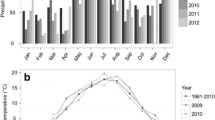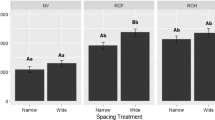Abstract
The objective of this study was to determine crop and tree productivity in several alley cropping planting patterns. The four- year study was conducted in western Oregon, United States and involved irrigated sweet corn (Zea mays) intercropped between hedgerows of red alder (Alnus rubra) and black locust (Robina pseudoacacia). Three alley cropping planting patterns with variable plant populations and tree-crop proximity were tested with each tree species in a randomized block design. Space available to trees and crops determined yield of both plant components. High crop yield coincided with low pruning yield, and vice versa. Compared to monocropping, yield reductions in traditional alley cropping planting patterns with widely spaced, double tree rows ranged from 5% to 15%. A. rubra and R. pseudoacacia coppiced readily and produced 0.9 to 4.7 tons of dry matter pruning biomass per growing season, depending on planting pattern and year. A. rubra yield continually increased during the trial, while the ability of R. pseudoacacia to produce green manure after frequent coppicing appeared to weaken. After four years, soil organic matter was 4 to 7% higher in the topsoil of an alley cropping system compared to a monocropping system. However, continuous growing of sweet corn resulted in decreased soil organic matter levels in both cropping systems compared to original levels. Crop yield reductions and the need for additional management inputs constrain the implementation of alley cropping in temperate climates. Only if benefits other than minor soil fertility improvements are realized is alley cropping a feasible alternative in temperate climate regions.
Similar content being viewed by others
References
Bergez JE, Auclair D and Bouvarel L (1989) First-year growth of hybrid poplar shoots from cutting or coppice origin. Forest Sci 35: 1105–1113
Binkley DK and Baker DD (1994) Nitrogen fixation by red alder. In: Hibbs DE, DeBell DS, and Tarrant RF (eds) The Biology and Management of Red Alder. Oregon State University Press, Corvallis, USA
Buck MG (1986) Concepts of resource sharing in agroforestry systems. Agrofor Syst 4: 191–203
Dawson JO (1986) Actinorhizal plants: their use in forestry and agriculture. Outl Agricult 15: 202–208
Delver P and Post A (1986) Influence of alder hedges on the nitrogen nutrition of apple trees. Plant Soil 28: 325–336
Friedrich JM and Dawson JO (1984) Soil nitrogen concentration and Juglans nigra growth in mixed plots with nitrogen fixing Alnus, Elaeagnus, Lespedeza and Robina species. Can J For Res 14: 864–868
Gichuru MP and Kang BT (1989) Callindra calothyrsus (Meissn.) in an alley cropping system with sequentially cropped maize and cowpea in southwestern Nigeria. Agrofor Syst 9: 191–203
Gold MA and Hanover JW (1987) Agroforestry systems for the temperate zone. Agrofor Syst 5: 109–121
Huxely PA and Maingu Z (1978) Use of systematic spacing designs as an aid to the study of intercropping: some general considerations. Exp Agric 14: 49–56
Kang BT, Wilson GF and Lawson TL (1985) Alley cropping: a stable alternative to shifting cultivation. Ibadan, Nigeria, IITA
Kurdali F, Domenach AM and Bardin R (1990) Alder-poplar associations: determination of plant nitrogen sources by isotope techniques. Biol Fert Soils 9: 321–329
Lawson TL and Kang BT (1990) Yield of maize and cowpea in an alley cropping system in relation to available light. Agric For Meteorol 52: 347–357
Mazzarino MJ, Szott LT and Jimenez JM (1993) Dynamic of soil total C and N, microbial biomass, and water soluble C in tropical agroecosystems. Soil Biol Biochem 25: 205–214
Rao MR, Sharma MM and Ong CK (1990) A study of hedgerow intercropping in semi-arid India using a two-way systematic design. Agrofor Syst 11: 243–258
Rosecrane RC, Brewbaker JL and Fownes JH (1992) Alley cropping of maize with nine leguminous trees. Agrofor Syst 17: 159–168
SAS (1987) SAS/STAT guide to personal computers, Version 6. Carry, NC
Sanginga N, Zapata F, Danso SKA and Bowen GD (1990) Effect of successive cuttings on uptake and partitioning of 15N among plant parts of Leucena leucocephala. Biol Fertil Soils 9: 37–42
Seiter S, Ingham ER, Horwath WR and William RD (1995) Increase in soil microbial biomass and transfer of nitrogen from alder to sweet corn in an alley cropping system. In: Ehrenreich JH, Ehreneich DL and Lee HW (eds), Growing a Sustainable Future, Proc 4th Conf Agrofor North America, Boise, ID
Sennerby-Forsse L, Ferm A and Kauppi A (1992) Coppicing ability and sustainability. In: Mitchel CP (ed) Ecopysiology of short rotation forest crops. Elsevier, Netherlands
Singh RP, Ong CK and Saharan N (1989) Above-and below-ground interactions in alley cropping in semi-arid India. Agrofor Syst 9: 259–274
Sseskabembe CK (1985) Perspectives on hedgerow intercropping. Agrofor Syst 3: 339–356
Trenbath BR (1976) Plant interactions in mixed crop communities. In: Papendick RI, Sanchez PA, and Triplett GB (eds), Multiple Cropping, Spec Pub 27, pp 129–170, ASA, Madison, USA
Wilson GF, Kang BT and Mulongoy K (1986) Alley cropping: trees as sources of green manure and mulch in the tropics. Biol Agric Hort 3: 251–267
Yamoah CF, Agaboola AA, Wilson GF and Mulongoy K (1986) Soil properties as affected by the use of leguminous shrubs for alley cropping with maize. Agric Ecosyst Environm 18: 67–177
Yamoah CF and Burleigh JR (1990) Alley cropping Sesbania sesban L. Merill with food crops in the highland region of Rwanda. Agrofor Syst 10: 169–181
Author information
Authors and Affiliations
Corresponding author
Rights and permissions
About this article
Cite this article
Seiter, S., William, R.D. & Hibbs, D.E. Crop yield and tree-leaf production in three planting patterns of temperate-zone alley cropping in Oregon, USA. Agroforestry Systems 46, 273–288 (1999). https://doi.org/10.1023/A:1006204018212
Issue Date:
DOI: https://doi.org/10.1023/A:1006204018212




